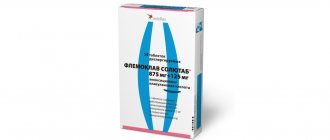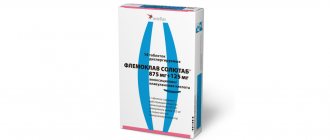Indications
Suprax is intended for the treatment of infectious and inflammatory processes caused by bacteria that are sensitive to cefixime. Therefore, before starting treatment, it is necessary to undergo tests to determine the causative agent of the infection. Thus, Suprax is used for the following diseases:
- infections of the nasopharynx and upper respiratory tract (sinusitis, acute pharyngitis, agranulocytic tonsillitis, chronic pharyngitis, sinusitis, tonsillitis);
- infections of the lower respiratory tract (acute and chronic bronchitis of bacterial origin, pneumonia);
- otitis media;
- uncomplicated urinary tract infections (cystitis, urethritis, pyelonephritis);
- uncomplicated gonorrhea (cervical, urethral);
- shigellosis.
Contraindications
The antibiotic has a number of contraindications, including:
- individual intolerance or hypersensitivity to the components of the drug;
- chronic renal failure;
- a history of severe allergic reactions to drugs from the group of cephalosporins and penicillins;
- lactation period;
- pseudomembranous colitis;
- children under 12 years of age (for capsules);
- children up to 6 months (for suspension);
- with caution: old age.
Inexpensive analogues for children
Bacterial infection often affects children's bodies. However, he also requires antibiotics. There are special forms of such drugs that are intended for treating children. Popular and inexpensive antibacterial agents that can be given to a child include Ceftriaxone, Ixim Lupin, and Cefix.
Ixim Lupine
This is a cefixime-based product that is produced in India. It belongs to the cephalosporins and is prescribed for infections of the respiratory tract, genitourinary system, and ENT organs that are caused by pathogenic bacteria sensitive to cefixime.
The drug is available in powder form for the preparation of a suspension, which is taken by both adults and children. The medicine is prepared as follows: pour clean water into a bottle with powder up to the mark and shake vigorously. This should result in a homogeneous liquid. Next, it is taken orally using a measuring spoon. The dosage depends on the age of the child:
- children from 6 months should take 2-4 ml per day;
- from 2 years – 5 ml;
- 5-12 years – 5-10 ml.
Adolescents over 12 years of age and weighing more than 50 kg, as well as adults, take 400 mg of cefixime per day. You can use the finished product for no more than 2 weeks. Side effects in children often include headaches, dysbacteriosis, nausea, constipation, stomatitis and allergic manifestations.
Ceftriaxone
Ceftriaxone is an antibiotic from the group of 3rd generation cephalosporins with a prolonged effect. It inhibits the cellular synthesis of certain groups of bacteria (including staphylococci and streptococci), showing resistance to their beta-lactamases.
The drug can be prescribed to children from the first day of life. The dosage is determined by the child’s weight:
- newborns are prescribed 20-50 mg per 1 kg of body weight per day;
- Children from 2 weeks to 12 years old are given 20-80 mg per 1 kg of body weight per day.
The main advantage of Ceftriaxone is its low cost. The drug can also be used to eliminate infectious processes (for example, sepsis and meningitis) in newborns.
Cefix
This is another drug based on cefixime. It has the same indications, contraindications and side effects as Suprax.
Available in the form of tablets, which are prescribed only to adults, and powder for the preparation of a suspension. The suspension is often used to treat children. Moreover, its dosage depends on the age and weight of the child - children from 6 months to 10 years are recommended to take 8 mg of cefixime per 1 kg of weight per day.
See also:
TOP 13 cheap substitutes for Enterosgel for children and adults
Side effects
During therapeutic treatment, Suprax may cause the following side effects:
- Allergic reactions: skin itching, skin flushing, eosinophilia, fever, urticaria, erythema multiforme, anaphylactic shock, toxic epidermal necrolysis, reactions resembling serum sickness.
- From the digestive system: dry mouth, anorexia, diarrhea, nausea, vomiting, abdominal pain, flatulence, transient increase in the activity of liver transaminases and alkaline phosphatase, hyperbilirubinemia, jaundice, gastrointestinal candidiasis, dysbacteriosis; rarely – stomatitis, glossitis, pseudomembranous enterocolitis.
One of the side effects of the drug is abdominal pain.
- From the hematopoietic system: agranulocytosis, neutropenia, thrombocytopenia, leukopenia, pancytopenia, bleeding, hemolytic and aplastic anemia.
- From the reproductive system: genital itching, vaginitis.
- From the urinary system: interstitial nephritis.
- From the nervous system: tinnitus, headache, dizziness, convulsions.
- Other: shortness of breath, candidomycosis;
Typically, these adverse reactions do not appear clearly enough and are mild. Therefore, in most cases, treatment cessation is not required.
Substitutes for Suprax 400 with similar effects
When Suprax does not work, or the patient is intolerant to its components, doctors recommend replacing it with other antibiotics with a similar mechanism of action. In this case, Amoxiclav, Klacid, Zinnat are often prescribed.
Klacid
It is an antibiotic from the macrolide group. It contains the active substance – clarithromycin. Its bactericidal effect extends to the following bacteria:
- legionella;
- mycoplasma;
- Helicobacter;
- some strains of staphylococci;
- chlamydia;
- mycobacteria.
Most often, the drug is prescribed for an infectious process in the respiratory tract (pharyngitis, bronchitis, pneumonia), bacterial skin lesions (folliculitis, erysipelas), mycobacterial infection, peptic ulcer due to infection by the Helicobacter bacterium. It is prohibited to use Klacid in the following patient conditions:
- intolerance to macrolide antibiotics;
- combination with certain medications (ergotamine, pimozide, astemizole, terfenadine);
- porphyric disease;
- period of pregnancy and lactation;
- age up to 3 years.
The medicine is released in the form of tablets for oral administration. One tablet may contain 250 or 500 mg of active substance. The daily dose is from 500 to 1000 mg, divided into 2 doses. The duration of treatment depends on the severity of the pathology - from 5 days to 2 weeks.
Most often, with the use of the drug, negative effects from the digestive system are observed, as well as headaches, allergic reactions and liver dysfunction.
Unlike Suprax, Klacid has a wider antibacterial spectrum, therefore it has a greater number of indications. But this remedy is more dangerous and has many contraindications and side effects.
Amoxiclav
This product contains 2 active ingredients - amoxicillin (an antibiotic) and clavulanic acid (a beta-lactamase inhibitor). Staphylococci, streptococci, enterococci, Helicobacter and many others are sensitive to its action. At the same time, clavulanic acid can inactivate beta-lactamase enzymes, which reduces the effect of penicillins and cephalosporins.
Amoxiclav is prescribed for various infectious diseases:
- osteomyelitis;
- otitis;
- pyelonephritis;
- cystitis;
- pneumonia;
- skin infections (including from animal bites).
It is not recommended to take the medicine if the patient has intolerance to penicillin, beta-lactam agents, or liver dysfunction while taking amoxicillin.
The antibiotic is produced in the form of tablets, which are approved for adults and adolescents from 12 years of age, as well as in the form of a liquid suspension for oral administration. The suspension can be given to infants from 6 months.
Amoxiclav has many side effects. Most often, when taking it, digestive problems occur; there may also be problems with hematopoiesis, candidiasis, convulsions, allergic reactions, and anaphylaxis.
The drugs Suprax and Amoxiclav differ in their belonging to different groups of antibiotics. At the same time, the effect of Amoxiclav is somewhat weaker; it also needs to be taken several times a day.
Zinnat
This is an antimicrobial agent based on cefuroxime. This substance has a bactericidal effect against staphylococci, streptococci and other pathogenic microorganisms.
Indications for prescribing the drug are diseases caused by bacteria sensitive to cefuroxime. It is used to treat infections of the skin and soft tissues, respiratory and genitourinary systems. Do not use the medicine if the patient has hypersensitivity to tselasporins and other types of antibiotics (penicillins, carbapenems).
The medicine is available in tablet form containing 125, 250 or 500 mg of cefuroxime. They are prescribed to adults and children. The dosage for them is determined by the severity of the pathology and body weight:
- adults and children weighing more than 40 kg are prescribed 250 or 500 mg per day;
- Children weighing less than 40 kg are advised to take 10 or 15 mg per kg of body weight per day.
Side effects are rare and reversible. Sometimes the patient develops allergic manifestations, candidiasis, and gastroenterological disorders.
The product differs from Suprax by the manufacturer (UK). Also, both drugs belong to different groups of antibacterial drugs.
See also:
TOP 10 analogues of Chlorprothixene - substitutes for children and adults
How to take Suprax
According to the instructions for use, Suprax is taken orally once a day, regardless of food intake.
How to drink Suprax correctly
Capsules for oral administration
- children from 6 months to 12 years: 8 mg/kg body weight 1 time/day. or 4 mg/kg every 12 hours;
- children over 12 years of age weighing more than 50 kg and adults: 400 mg 1 time / day.
Oral suspension
- children from 6 months to 1 year: 2.5-4 ml/day;
- children 2-4 years old: 5 ml/day;
- children 5-11 years old: 6-10 ml/day.
To properly prepare the suspension, shake the granules in the bottle, gradually pour 40 ml of cool water into it, shaking thoroughly each time until a homogeneous suspension is formed. If cooking in a bottle is not possible, then you should use glass or enamel containers. To completely dissolve the granules, you should let the resulting solution stand for about five minutes. Suprax suspension does not need to be stored in the refrigerator.
The duration of the course of therapy depends on the diagnosis, the severity of the disease, the presence of complications and the characteristics of the patient’s body. It is determined by the attending physician. On average, treatment lasts 7-10 days.
- for gonorrhea – 1 day;
- for mild forms of genitourinary infection – from 3 to 7 days;
- for angina, Suprax is prescribed in a course of 7-14 days (for angina in children, the daily dose is reduced).
It is worth noting that with prolonged use of Suprax, the patient may experience chronic diarrhea and the subsequent development of severe colitis.
Also, while taking the drug, dizziness or attacks of severe headache may occur. It is better to refrain from driving a car or using complex equipment that requires immediate response or concentration.
Analogues of the drug Suprax Solutab in composition
Most often, medications with identical composition are used to replace Suprax. They have the same indications, limitations and side effects.
Pantsef
This antibacterial agent contains cefixime. It is produced in Macedonia by JSC Alkaloid. The drug is classified as a cephalosporin antibiotic. Its action is aimed at inhibiting the cellular biosynthesis of pathogenic microflora, while it is resistant to their beta-lactamases.
Pancef is prescribed to eliminate the infectious process in the respiratory tract (bronchitis, pharyngitis), ENT organs (sinusitis, otitis media), and urinary tract. It is also used to treat uncomplicated gonorrhea (a sexually transmitted disease).
It is prohibited to prescribe the medicine to the following groups of patients:
- people with hypersensitivity to antibiotics from the class of penicillins and cephalosporins;
- children under 12 years (tablets) and up to 6 months (suspension);
- lactating women.
The medicine is used with caution in cases of kidney failure, colitis, and also for the treatment of elderly people. Pregnant women should only be prescribed the drug if absolutely necessary.
The drug is produced in the form of powder or tablets for oral administration. Tablets are prescribed only to adults and adolescents over 12 years of age; those weighing more than 50 kg are prescribed 400 mg per day. The duration of therapy is no more than 10 days. The dosage of the suspension depends on the age and body weight of the patient:
- adults are prescribed 20 ml (400 mg of active ingredient) per day;
- children weighing less than 6 kg – 2.5 ml (50 mg);
- a child about a year old (weight up to 12 kg) – 5 ml (100 mg);
- children weighing no more than 25 kg - 10 ml (200 mg);
- adolescents weighing up to 37 kg are prescribed 15 ml (300 mg).
The drug may provoke the development of negative reactions. In this case, a person experiences:
- nausea, vomiting, abdominal pain, dysbacteriosis;
- allergic manifestations;
- dizziness;
- headache;
- vaginitis, candidiasis;
- lack of B vitamins;
- dyspnea.
In especially severe cases, complications arise in the form of suppression of hematopoiesis, bleeding, dysfunction of the liver and kidneys (nephritis), and toxic damage to the skin.
Pantsef is practically no different from Suprax. Both drugs have identical composition and mechanism of action. The difference is the country of origin. It is believed that Suprax is a higher quality medicine, and therefore costs more.
Ceforal Solutab
The drug is a complete analogue of Suprax Solutab. It is also available in the form of fast-acting tablets, each containing 400 mg of cefixime. It has similar indications for use, limitations and side effects.
This form has some features in application:
- The tablets are drunk whole or pre-dissolved in water;
- they are intended for the treatment of adults or adolescents over 12 years of age weighing more than 50 kg;
- take 1 tablet once a day or divide it into 2 doses;
- the therapeutic course lasts until the symptoms disappear and an additional 2-3 days (prevention of relapse of infection);
- For patients with renal failure, the dosage is reduced by 2 times (200 mg per day).
Ceforal differs from Suprax only by the manufacturer (the drug is produced in Italy). In addition, it has only 1 release form - dispersible tablets, therefore it is contraindicated for small children.
See also:
TOP 11 cheap analogues of Enterol - Russian drugs for adults and children
Suprax during pregnancy and breastfeeding
Taking Suprax during pregnancy is prescribed only if there is a threat to the life of the mother. Moreover, this is possible only in the second and third trimesters. In the first trimester, taking Suprax can cause abnormalities or congenital deformities in the fetus.
Suprax during pregnancy
Suprax is contraindicated during lactation. If the drug is still prescribed, it is necessary to transfer the child to artificial feeding.
Suprax's analogs
Do you know why Suprax is better than its analogues? It is used to treat aggressive pathogens, and is quite effective. And all this is outpatient! The drug can also be used gradually, that is, the doctor has the opportunity to prescribe step-by-step therapy. This is necessary in fairly serious cases. Treatment begins with parenteral forms of 3rd generation cephalosporins, and after 2-3 days, when the patient’s condition has improved, they switch to oral administration of Suprax.
Suprax's analogs
The following drugs have a similar therapeutic effect with Suprax capsules:
- Amoxicillin;
- Amoxiclav;
- Flemoxin;
- Cefatoxime;
- Ceftriaxone;
- Sumamed;
Synonyms (drugs containing the same active substance) are:
- Ixim lupine;
- Pantsef;
Remember that only the attending physician can replace one drug with another, who takes into account not only the severity of the patient’s condition, the nature of the disease, but also contraindications and possible side effects.
Suprax/Pancef
These antibiotics are based on the same active substance. If you rely on patient reviews, then when taking Pancef, the body is less likely to show negative reactions in the form of side effects.
Suprax/Sumamed
Sumamed basically contains azithromycin, which has a broader antimicrobial effect. Sumamed is prescribed to children; it causes fewer side effects and the course duration is shorter.
Suprax/Amoxiclav
Unlike Amoxiclav, Suprax is better tolerated and less likely to cause dysbiosis and other gastrointestinal disorders.
Release forms and list of analogues with prices in rubles
Suprax is available in several dosage forms. They have their own characteristics:
- Fast-acting (dispersible) tablets. They look like an oblong orange tablet with a strawberry smell. Such tablets are drunk whole or dissolved in water before taking, and then the resulting liquid is drunk in one gulp. 1 tablet contains 400 mg of active ingredient. There are 6 pieces in a package.
- Capsules. They are intended for oral administration. The capsule shell is yellow (200 mg of cefixime) or violet (400 mg) in color, inside which contains white powder and small granules. Capsules are packaged in cellular blisters of 3 pieces. The cardboard box contains 2 blisters (6 capsules).
- Powder. It looks like white or slightly yellowish granules, which are packaged in 60 ml glass bottles. To prepare the medicine, you need to pour purified water up to the mark on the bottle and shake well. The prepared solution is beige in color and smells like strawberries. For ease of dosing, the kit includes a measuring spoon. 5 ml of suspension contains 100 mg of cefixime.
Suprax has many substitutes that contain the same active substance. They differ only in manufacturer and, accordingly, price. The most famous analogues in composition:
- Pancef (Macedonia);
- Ceforal Solutab (Italy);
- Cefixime;
- Cemidexor;
- Ixim Lupine (India);
- Cefspan (Japan).
The cost of such drugs is slightly lower than that of Suprax. Their price in rubles depends on the form of release, the content of the active substance, as well as the place where the drug was purchased. If Suprax capsules of 400 mg (6 pieces) cost about 700 rubles, then for a package of Pancef tablets (6 pieces of 400 mg each) you should pay up to 500 rubles.
See also:
TOP 15 analogues of Enterofuril - a list of cheap Russian drugs for children and adults
Additional information about the drug
So, cephalosporins are antibiotics that are characterized by a wide spectrum of action; they are highly bactericidal and immune to beta-lactamases (bacterial enzymes that destroy the antibiotic, causing its action to become ineffective). In general, in some ways, cephalosporins are more effective than penicillins. And Suprax is based on third generation cephalosporins. And this is the first such antibiotic that can be taken orally. Suprax is based on cefixime. Cefixime affects the cell wall of the pathogen, inhibiting its formation.
Suprax inhibits the vital activity of streptococci, Haemophilus influenzae, Escherichia coli, Proteus, Salmonella, Citrobacter and gonococci. However, Suprax is powerless against Pseudomonas aeruginosa, most staphylococci, enterobacters and listeria. As for taking the drug, food does not affect its bioavailability in any way. Yes, it prolongs the period of reaching the maximum content in the blood and that’s all. Another good thing about Suprax is that you need to take it once a day. This is due to the half-life of the drug from the body. It takes a long time to come out. About 50% of the drug is excreted in the urine. And this is great because it is effective in treating urinary tract infections. However, it is better not to take it with diuretics, as the withdrawal of the drug is slowed down. In general, Suprax penetrates well to the site of infection. The main foci of infection with which Suprax interacts are the middle ear cavity, paranasal sinuses, tonsils, lungs, and bile ducts. If we rely on patient reviews about taking Suprax, they note a slight suppression of intestinal microflora. You can find Suprax in two dosage forms that are aimed at different age groups: 400 mg capsules for adult patients and granules for the preparation of a strawberry-flavored suspension 100 mg / 5 ml - 60 ml for children.



